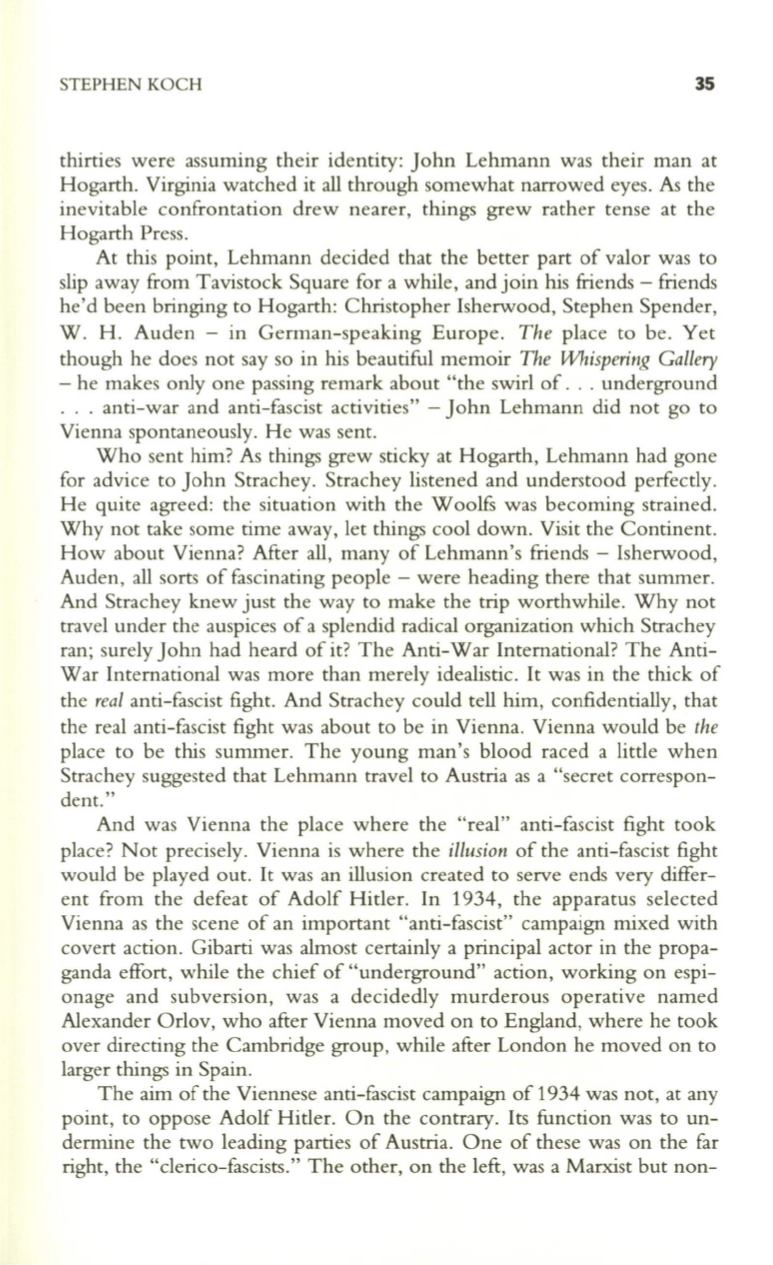
STEPHEN KOCH
35
thirties were assuming their identity: John Lehmann was their man at
Hogarth. Virginia watched it
all
through somewhat narrowed eyes. As the
inevitable confrontation drew nearer, things grew rather tense at the
Hogarth Press.
At this point, Lehmann decided that the better part of valor was to
slip away from Tavistock Square for a while, and join his friends - friends
he'd been bringing to Hogarth: Christopher Isherwood, Stephen Spender,
W. H . Auden - in German-speaking Europe.
The
place to be. Yet
though he does not say so in his beautiful memoir
The Whispering Gallery
- he makes only one passing remark about "the swirl of ... underground
... anti-war and anti-fascist activities" -John Lehmann did not go to
Vienna spontaneously. He was sent.
Who sent him? As things grew sticky at Hogarth, Lehmann had gone
for advice to John Strachey. Strachey listened and understood perfectly.
He quite agreed: the situation with the W oolfs was becoming strained.
Why not take some time away, let things cool down. Visit the Continent.
How about Vienna? After
all,
many of Lehmann's friends - Isherwood,
Auden,
all
sorts of fascinating people - were heading there that summer.
And Strachey knew just the way to make the trip worthwhile . Why not
travel under the auspices of a splendid radical organization which Strachey
ran; surely John had heard of it? The Anti-War International? The Anti–
War International was more than merely idealistic. It was in the thick of
the
real
anti-fascist fight . And Strachey could tell him, confidentially, that
the real anti-fascist fight was about to be in Vienna. Vienna would be
the
place to be this summer. The young man's blood raced a little when
Strachey suggested that Lehmann travel to Austria as a "secret correspon–
dent."
And was Vienna the place where the "real" anti-fascist fight took
place? Not precisely. Vienna is where the
illusion
of the anti-fascist fight
would be played out.
It
was an illusion created to serve ends very differ–
ent from the defeat of Adolf Hitler. In 1934, the apparatus selected
Vienna as the scene of an important "anti-fascist" campaign mixed with
covert action. Gibarti was almost certainly a principal actor in the propa–
ganda effort, while the chief of "underground" action, working on espi–
onage and subversion, was a decidedly murderous operative named
Alexander Orlov, who after Vienna moved on to England, where he took
over directing the Cambridge group, while after London he moved on to
larger things in Spain.
The aim of the Viennese anti-fascist campaign of 1934 was not, at any
point, to oppose Adolf Hitler. On the contrary. Its function was to un–
dermine the two leading parties of Austria. One of these was on the far
right, the "clerico-fascists." The other, on the left, was a Marxist but non-


